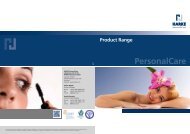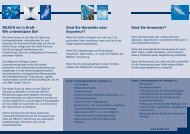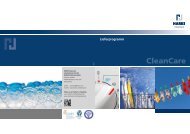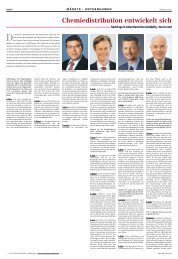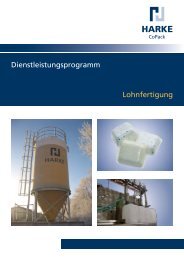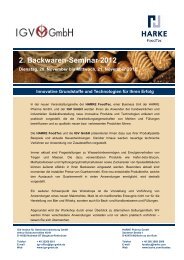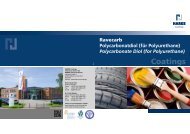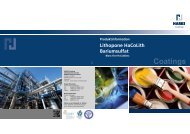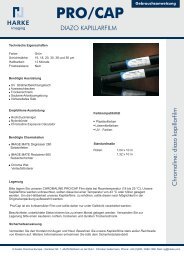information Value of Sultaines - HARKE Group
information Value of Sultaines - HARKE Group
information Value of Sultaines - HARKE Group
Create successful ePaper yourself
Turn your PDF publications into a flip-book with our unique Google optimized e-Paper software.
Magazine<br />
JANUARY 2012<br />
Volume 32 No. 01<br />
Hand in<br />
glove<br />
Handling HPAPIs safely<br />
Change<br />
<strong>of</strong> power<br />
CMOs in high potency<br />
Plus: Surfactants Chemocatalysts REACH Implementation Boronic Acids & Esters Latest News<br />
www.specchemonline.com
Surfactants<br />
The value <strong>of</strong> sultaines<br />
Regina Cosby and Frank Wagner <strong>of</strong> Rhodia take a new look at amphoteric surfactants*<br />
Amphoteric surfactants are commonly used by<br />
formulators in personal care applications, such as<br />
body washes, shampoos and facial cleansers, and<br />
in home care formulations like hard surface cleaners and<br />
laundry and dish detergents. They typically allow<br />
formulators to reduce the irritation potential <strong>of</strong> anionic<br />
surfactants, develop formulation viscosity and enhance<br />
foam quality in terms <strong>of</strong> texture, volume and stability.<br />
Cocamidopropyl betaine (CAPB, Figure 1a) is a widely<br />
used amphoteric surfactant in the home and personal<br />
care industries, although it can limit formulators in<br />
developing higher performance products at a lower<br />
formulation cost. <strong>Sultaines</strong>, such as cocamidopropyl<br />
hydroxysultaine (CAPHS, Figure 1b) are an amphoteric<br />
option that <strong>of</strong>fer improved foam quality, enhanced<br />
mildness and cost-effectiveness and are environmentally<br />
favourable.<br />
The molecular design <strong>of</strong> sultaines enhances mildness<br />
and foam performances and can solve key formulation<br />
challenges <strong>of</strong> sulfate- and ethoxylate-free formulations in<br />
personal care. <strong>Sultaines</strong> bring extra clarity and stability<br />
when compared to betaines, due to their stronger<br />
hydrotroping properties, and are extremely tolerant in<br />
hard water environments. They have identical viscosity<br />
development to betaines and can easily replace them in<br />
home and personal care formulations.<br />
Chemistry <strong>of</strong> sultaines<br />
<strong>Sultaines</strong> are the inner sulfonic acid salt <strong>of</strong> a strong<br />
inorganic acid and are commonly referred to as<br />
‘sulfobetaines.’ They are similar to betaines, which are<br />
inner carboxylic acid salts <strong>of</strong> a weak organic acid. 1<br />
Both molecules are considered zwitterionic at neutral<br />
pH where the nitrogen on the hydrophobic tail is<br />
quaternary (cationic); the polar head groups are anionic<br />
and add to the hydrophilic properties <strong>of</strong> the molecule.<br />
Because the quaternary nitrogen is always positive, these<br />
molecules cannot obtain anionic nature at any pH and are<br />
not truly amphoteric, although they are commonly<br />
referred to as such.<br />
The alkyl chain length varies, depending on the<br />
feedstock used. In personal care formulations, higher<br />
hydrophobic alkyl chain lengths <strong>of</strong> C 12-14 are preferred for<br />
optimum foaming, mildness and viscosity building<br />
properties.<br />
Foam volume (ml)<br />
500<br />
400<br />
300<br />
200<br />
100<br />
With disodium<br />
Lauryl sulfosuccinate<br />
CAPHS-FA<br />
CAPB-FA<br />
LAPHS-FA<br />
LAPB-FA<br />
CAPHS-T<br />
CAPB-T<br />
Figure 1 - CAPB & CAPMS<br />
Figure 2 - Foam volume <strong>of</strong><br />
betaines & sultaines <strong>of</strong><br />
varying feedstocks with<br />
common anionics<br />
With sodium coco-sulfate<br />
CAPH-FA<br />
CAPB-FA<br />
LAPHS-FA<br />
LAPB-FA<br />
CAPHS-T<br />
CAPB-T<br />
a - Cocamidopropyl<br />
betaine<br />
b - Cocamidopropyl<br />
hydroxysultaine<br />
O<br />
CH 3<br />
R N N + O -<br />
H<br />
Although sultaines and betaines are similar in structure,<br />
the slight difference in the head group <strong>of</strong> the molecule is<br />
what gives sultaines their different properties. A betaine’s<br />
head group is a weakly anionic carboxylic acid that binds<br />
easily to divalent cations, such as calcium and<br />
magnesium. <strong>Sultaines</strong> consist <strong>of</strong> a strong anionic<br />
sulfonate group that overpowers the cationic properties<br />
<strong>of</strong> the quaternary nitrogen.<br />
This small difference in the molecule is what gives<br />
sultaines their enhanced properties over their betaine<br />
counterparts, such as strong alkali stability, excellent lime<br />
soap dispersion and enhanced coupling. When<br />
manufactured, sultaines are naturally higher in terms <strong>of</strong><br />
active content than betaines without the use <strong>of</strong> solvents<br />
and they are free <strong>of</strong> preservatives, processing aids and<br />
chelants.<br />
Improved foam properties<br />
Foam tests <strong>of</strong> various anionic: amphoteric combinations<br />
were evaluated at 0.1% actives at a ratio <strong>of</strong> 1.5:1 to<br />
study further the properties <strong>of</strong> sultaines in personal care.<br />
Since amphoterics display different properties at various<br />
pH ranges, foam volume was measured at both pH 4.0<br />
and 7.0. The testing parameters for all foam studies were:<br />
no soil, an ambient temperature <strong>of</strong> 22°C and water with<br />
a hardness <strong>of</strong> approximately 150 ppm calcium and<br />
magnesium ions.<br />
The process used an automatic cylinder shake foam<br />
apparatus from Guam that consisted <strong>of</strong> placing 100 ml <strong>of</strong><br />
test solution in a 500 ml graduated cylinder and inverting<br />
it ten consecutive times and at a frequency <strong>of</strong> 30 rpm. The<br />
foam volume, expressed in ml, is measured immediately<br />
following last inversion, t=0, and after five minutes, t=5.<br />
The initial foam volume indicated flash foam properties<br />
and the reading after five minutes indicated foam<br />
stability. All samples were run in duplicate using a least<br />
significant difference <strong>of</strong> 90%.<br />
Figure 2 shows the foam volume <strong>of</strong> betaines and<br />
sultaines <strong>of</strong> varying feedstock combined with two <strong>of</strong> the<br />
anionic surfactants tested, disodium lauryl sulfosuccinate<br />
and sodium coco-sulfate. The feedstock varieties included<br />
betaine and sultaines derived from triglycerides (CAPB-T<br />
and CAPHS-T), those derived from coconut fatty acid<br />
(CAPB-FA and CAPHS-FA) and those derived from lauric<br />
acid (LAPB-FA and LAPHS-FA).<br />
26 Speciality Chemicals Magazine January 2012 www.specchemonline.com<br />
R<br />
O<br />
N<br />
H<br />
CH 3<br />
O<br />
CH 3<br />
N + S O<br />
O O<br />
CH 3 OH
Surfactants <br />
Foam volume (ml)<br />
500<br />
450<br />
400<br />
350<br />
300<br />
250<br />
SLES-2<br />
SLES-3<br />
Anionic neat<br />
SLES-2<br />
Combos<br />
Triglyceride<br />
<strong>Sultaines</strong><br />
Betaines<br />
SLES-3<br />
Combos<br />
In all cases, at a 90% confidence level, sultaines<br />
statistically outperformed their betaine counterpart <strong>of</strong> the<br />
same feedstock in both pH environments. In terms <strong>of</strong><br />
foam stability, betaines and sultaines displayed similar<br />
abilities to stabilise foam volume at five minutes. During<br />
the study, it was observed that the sultaine combination<br />
solutions were clear and the betaine combinations were<br />
hazy when combined with each <strong>of</strong> the high Kraft point<br />
anionics.<br />
This mimics the hydrotroping properties <strong>of</strong> sultaines<br />
that have been studied in hard surface cleaners. The<br />
superior performance is most likely due to the greater<br />
charge neutralisation <strong>of</strong> the molecule. Further studies are<br />
planned to evaluate these coupling properties<br />
quantitatively in a personal care formulation.<br />
Sodium coco-sulfate has a dense, creamy foam quality<br />
that is further stabilised with the addition <strong>of</strong> amphoterics.<br />
Figure 2 shows that there was a significant improvement<br />
in the foam quantity <strong>of</strong> sultaines over betaines with<br />
sodium coco-sulfate in all feedstock cases.<br />
Using the same conditions as this study, further foam<br />
work focused on standard, triglyceride-based amphoterics<br />
to explore the effect <strong>of</strong> the ethoxylation <strong>of</strong> the anionic on<br />
the foam performance <strong>of</strong> sultaines. The triglyceride-based<br />
sultaines outperformed the betaines and the foam volume<br />
<strong>of</strong> the sodium laureth sulfate (SLES)/sultaine combinations<br />
were significantly impacted by the degree <strong>of</strong> ethoxylation<br />
on the SLES molecule (Figure 3).<br />
SLES-3/sultaine foamed significantly higher than the<br />
SLES-2/sultaine yet the ethoxylation differences did not<br />
have an effect on the SLES/betaine combinations. All<br />
anionic/amphoteric surfactant combinations have a<br />
denser and more stable foam quality and do not have as<br />
high a foam volume as the neat anionic surfactants.<br />
Viscosity building<br />
Viscosity comparisons used two base formulations that<br />
only varied the test surfactant to evaluate viscosity<br />
building properties with electrolytes. Viscosity readings<br />
were measured when the samples reached 25°C in a<br />
water bath by using a Brookfield LVT Viscometer, spindle<br />
#3, after one minute. The speed on the viscometer was<br />
adjusted accordingly from 3 to 12 rpm or when the<br />
sample measured 50% torque.<br />
Two common surfactant systems were analysed, based<br />
on 12% active SLES-2/3% active test surfactant and 16%<br />
active SLES-1/1.6% active cocamide MEA/1.5% active test<br />
surfactant respectively. Similar to the foam studies, the<br />
test surfactants consisted <strong>of</strong> sultaines and betaines<br />
derived from various feedstocks including triglycerides<br />
(whole coconut oil), coconut fatty acid or lauric fatty acid.<br />
Figure 3 - Foam volume <strong>of</strong><br />
SLES-3/sultaine<br />
combination<br />
The objective was to determine if sultaines <strong>of</strong> various<br />
feedstocks built viscosity as well as their corresponding<br />
betaine counterparts. Each system was balanced to 100%<br />
by weight with distilled water and adjusted to pH 7.0±0.2<br />
using citric acid. Initial readings were measured, then<br />
sodium chloride was added in 0.2-0.5% increments.<br />
The results (Figure 4) demonstrate that a sultaine and<br />
betaine derived from the same feedstock build viscosity in a<br />
similar way. The addition <strong>of</strong> an alkanolamide made more <strong>of</strong><br />
an impact on viscosity response due to its strong hydrogen<br />
bonding with electrolytes. For example, a sultaine and a<br />
betaine, both based on coconut fatty acid, both built<br />
viscosity in a similar way in the system that contained an<br />
amide and in the one without it.<br />
In the formulation without amide, both test<br />
formulations with coconut fatty acid-based amphoterics<br />
reached an ideal personal care formulation viscosity <strong>of</strong><br />
10,000-15,000 cps with 1.5% sodium chloride. When an<br />
amide was present, the formulations reached this same<br />
viscosity range at 0.5% sodium chloride, even though<br />
half the amount <strong>of</strong> coconut fatty acid-based amphoterics<br />
was used.<br />
The same patterns were observed for lauric fatty acidor<br />
triglyceride-based sultaines and their betaine<br />
counterparts. Viscosity response showed the following<br />
sequence between alkyls as contributors to the viscosity<br />
build <strong>of</strong> amphoterics: in both systems tested, with or<br />
without the addition <strong>of</strong> a non-ionic, lauric fatty acid ><br />
coconut fatty acid > coconut oil.<br />
Viscosity build is therefore a function <strong>of</strong> the alkyl chain<br />
length and/or chain distribution <strong>of</strong> the amphoteric.<br />
Betaines and sultaines build viscosity in a similar way.<br />
Based on the two systems tested, sultaines can replace<br />
betaines with minimal difference in viscosity building in<br />
personal care formulations.<br />
Reduced irritation<br />
MatTek’s patented EpiOcular test was used to evaluate<br />
and compare the effect that a sultaine and a betaine has<br />
on reducing the irritation <strong>of</strong> anionic surfactants. Mildness<br />
was evaluated in vitro by MatTek using its corneal model<br />
that consists <strong>of</strong> cultured epidermal cells similar to those<br />
found in the cornea. The model provides a predictive<br />
means to assess ocular irritancy in vitro.<br />
Table 1 - EpiOcular test results <strong>of</strong> SLES-2 or sodium coco-sulphate, sultaine & betaine<br />
combinations<br />
Sodium<br />
laureth-2<br />
sulfatebased<br />
combinations<br />
Sodium<br />
cocosulfatebased<br />
combinations<br />
Sample description Draize Sample description Draize<br />
score<br />
score<br />
15% active SLES-2 48.9 Johnson & Johnson NMT 9.1<br />
15% active CAPHS 67.2 15% active CAPB 67.2<br />
11.25% active SLES-2 11.25% active SLES-2<br />
4.75% active CAPHS 40.7 4.75% active CAPB 37.1<br />
7.5% active SLES-2 7.5% active CAPHS<br />
7.5% SLES-2 14.4 7.5% active CAPB 18.0<br />
4.75% active SLES-2 4.75% active SLES-2<br />
11.25% active CAPHS 6.6 11.25% active CAPB 22.4<br />
10% active coco-sulfate 102.5 Johnson & Johnson NMT 9.1<br />
10% active CAPHS 97.0 10% active CAPB 65.4<br />
7.5% active coco-sulfate 7.5% active coco-sulfate<br />
2.5% active CAPHS 75.7 2.5% active CAPB 58.3<br />
5.0% active coco-sulfate 5.0% coco-sulfate<br />
5.0% active CAPHS 20.1 5.0% active CAPB 20.4<br />
2.5% active coco-sulfate 2.5% active coco-sulfate<br />
7.5% active CAPHS 13.8 7.5% active CAPB 17.3<br />
www.specchemonline.com January 2012 Speciality Chemicals Magazine 27
Surfactants<br />
Viscosity (cps)<br />
120,000<br />
100,000<br />
80,000<br />
60,000<br />
40,000<br />
20,000<br />
0<br />
0.0 0.5 1.0 1.5 2.0 2.5<br />
NaCl (%)<br />
Hydroxysultaines<br />
SLES-1/CMEA<br />
systems<br />
CAPB-FA<br />
LAPB-FA<br />
LAPHS-FA<br />
CAPHS-FA<br />
CAPHS-T<br />
CAPB-T<br />
Betaines<br />
SLES-2<br />
systems<br />
CAPB-FA<br />
LAPB-FA<br />
CAPHS-FA<br />
LAPHS-FA<br />
CAPHS-T<br />
CAPB-T<br />
CAPHS-FA LAPHS-FA CAPHS-T CAPB-FA LAPB-FA CAPB-T<br />
The procedure uses a water-soluble, yellow tetrazolium<br />
salt (MTT {3-[4,5-dimethylthiazol-2-yl]-2,5-diphenyltetrazolium<br />
bromide}), which is reduced by succinate<br />
dehydrogenase in the mitochondria <strong>of</strong> viable cells to a<br />
purple, insoluble formazan derivative. Substances which<br />
damage this mitochondrial enzyme inhibit the reduction<br />
<strong>of</strong> the tetrazolium salt. The amount <strong>of</strong> MTT reduced by a<br />
culture is therefore proportional to the number <strong>of</strong> viable<br />
cells.<br />
As per MatTek’s protocol, the samples are diluted to a<br />
20% solution and the appropriate tissue preparation is<br />
made. 100 microlitres <strong>of</strong> the test article and distilled<br />
water (negative control) were added to the micelles<br />
containing the EpiOcular samples. The six-well plates<br />
containing the dosed EpiOcular samples were then<br />
incubated at 37°C, 5% CO 2 and >90% humidity. The<br />
results were then converted from an ET-50 value into a<br />
familiar estimated Draize score.<br />
According to this test, the ingredient is considered<br />
more or less irritating depending on the Draize Score: 0-<br />
15 means non-irritating, minimal, 15.1-25 is mild, 25.1-<br />
50 is moderate and 50.1-110 is considered severely<br />
irritating or extreme. Traditionally, true amphoterics or<br />
highly ethoxylated nonionics are used to reduce or<br />
minimise eye irritation <strong>of</strong> alkyl ethoxylated sulfates and<br />
alkyl sulfates. Previous studies show that betaines have<br />
minimal impact on this property. 2<br />
EpiOcular comparisons were made for two anionic<br />
combinations, one with SLES-2 and one with sodium<br />
coco-sulfate to determine if sultaines displayed similar<br />
Figure 4 - Viscosity<br />
responses <strong>of</strong> sultaines &<br />
betaines<br />
References<br />
1. McIntyre <strong>Group</strong>, McIntyre<br />
Chemistry Manual 1997, 46-60<br />
2. T. Schoenberg, Formulating<br />
with Betaine and Amphoteric<br />
Surfactants 1997, 2.<br />
3. F. Wagner, D. Colovic, J.<br />
Kiplinger, G. Cosby & E. Leroy, A<br />
Novel Look at Amphoteric<br />
Surfactants, Poster, 2010.<br />
Contact<br />
Denis Bendejacq<br />
Rhodia CTRA<br />
Labo Home & Personal<br />
Care<br />
52, rue de la Haie Coq<br />
F-93308 Aubervilliers<br />
France<br />
E-mail: denis.bendejacq@<br />
eu.rhodia.com<br />
Website: www.rhodia.com<br />
behaviour to betaines. The results (Table 1) show that,<br />
although all surfactants tested individually at 10-15%<br />
active were severely irritating, the combination <strong>of</strong> an<br />
anionic with either a betaine or sultaine starts to mitigate<br />
the irritation potential.<br />
<strong>Sultaines</strong> especially reduced the irritation when<br />
incorporating more sultaine than anionic in the SLES-<br />
2/amphoteric combinations. For example 11.25% CAPHS<br />
and 4.75% SLES-2 had a score <strong>of</strong> 6.6, non-irritating and<br />
the corresponding CAPB was 22.4, or mild. The score <strong>of</strong><br />
this SLES-2/CAPHS combination was even lower than the<br />
benchmark baby shampoo that claims ‘no more tears’.<br />
Similarly, the estimated Draize scores <strong>of</strong> sodium cocosulfate<br />
were reduced when incorporating a betaine or<br />
sultaine. The impact <strong>of</strong> the ethoxylation <strong>of</strong> the alkyl<br />
sulfate in combination with a sultaine was more dramatic<br />
than the sulfate/betaine combinations, as also indicated in<br />
the foam studies.<br />
Conclusion<br />
<strong>Sultaines</strong> molecular design makes them an ideal<br />
amphoteric choice for personal care formulations where<br />
mildness and foam are important. They are free <strong>of</strong><br />
processing aids and preservatives and are able to reduce<br />
the irritation <strong>of</strong> common anionics more efficiently than<br />
betaines.<br />
<strong>Sultaines</strong> are highly compatible with anionic surfactants<br />
and enhance foaming properties <strong>of</strong> ethoxylate-free<br />
surfactants such as sodium coco-sulfate and also sulfatefree<br />
surfactants such as disodium lauryl sulfosuccinate. In<br />
every combination <strong>of</strong> anionic/amphoteric, sultaines<br />
delivered superior or equal foam when compared to<br />
betaines at the 90% confidence level.<br />
Chain length <strong>of</strong> the betaine or sultaine and anionic<br />
selection is more important in boosting foam than pH<br />
effect. The degree <strong>of</strong> ethoxylation on an alkyl sulfate in<br />
combination with a triglyceride-based CAPHS has a<br />
favourable impact on mildness and foam. <strong>Sultaines</strong> build<br />
viscosity similarly to their betaine counterpart and can<br />
easily substitute them into a personal care formulation<br />
while simultaneously boosting foam and mildness.<br />
* - The authors would like to thank Dusanka Colovic Vos <strong>of</strong><br />
Rhodia, University Park, for her assistance in running many <strong>of</strong> the<br />
foam and viscosity tests, Jon Kiplinger and Tom Ruch <strong>of</strong> Rhodia<br />
CRTA for their assistance with EpiOcular correspondence and<br />
interpretation <strong>of</strong> results and Eric Leroy <strong>of</strong> CRTA for his guidance<br />
on relating the results to molecular structure as originally<br />
published in a poster format. 3 They would especially like to thank<br />
Denis Bendejacq <strong>of</strong> CRTA for all <strong>of</strong> his assistance and guidance in<br />
writing this article.<br />
Shortcut from Lab to Production<br />
THE R&D SERVICE PROVIDER FOR CHEMICAL MICRO PROCESS ENGINEERING<br />
Process intensification in micro- and milli-structured reactors<br />
• ml/h to m 3 /h • 0 to 1000 bar • -200°C to +1000°C<br />
Institut für Mikrotechnik Mainz GmbH | Germany | www.imm-mainz.de | Tel: +49 (0)6131 990-0 | E-Mail: info@imm-mainz.de<br />
28 Speciality Chemicals Magazine January 2012 www.specchemonline.com



